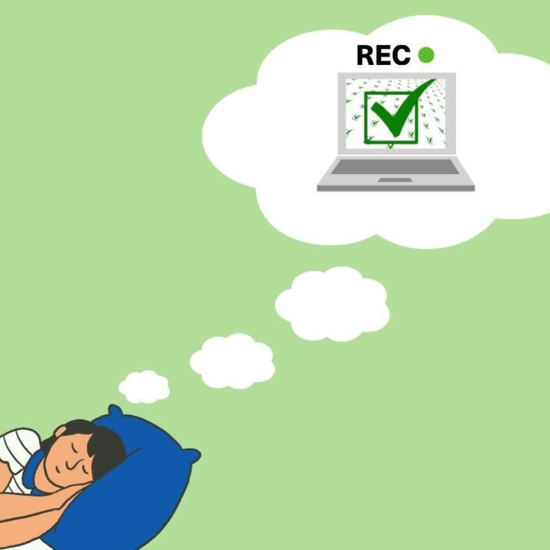
6 reasons why to rely on website monitoring with videos and E2E testing
- A video is a real proof of complete functionality and that lets us sleep more calmly
- External service providers have no more excuses and the madness has come to an end
- A video of a user story during website testing with Cypress.IO shows all requests
- With a video and screenshot you can immediately get to the location of the error and can react
- Editors in a content management system are human beings and are allowed to make mistakes
- Only a real user test with a real browser tells the truth
- Website monitoring and website testing are important topics
- Conclusion Website Testing as Monitoring with Video Recording
A video is a real proof of complete functionality and that lets us sleep more calmly

Not knowing whether a system for which you have sole technical responsibility is working properly can drive you to nervous insanity. Basically, you're just waiting for a call about a scenario you're dreading. This is where video proof can help. With automated tests like the ones we offer, they're an essential part of our offering. Not only do they document errors that occur and are uncovered by automated testing, but they clearly show where the error is happening. This provides security and ensures a peaceful night's sleep.
External service providers have no more excuses and the madness has come to an end

A large number of external service providers are integrated on a website. In addition to tracking and content delivery networks (CDNs), typical areas of use here are increasingly cookie consistent providers such as Usercentrics Consent Management. If these are not available or have high response times, this also costs a potential lead every time. This was exactly the case with one of our customers. For a customer registration test on Sunday morning, the response time from the cookie service provider was over 30 seconds. Our testing documented this case and the video was able to be submitted to the service provider. Without the video, the whole scenario could not have been proven at all or only with great effort.
For our own technical department or even the API provider, the error was too rare and not reproducible. The tests validated the entire system every 2 hours at a rate of 5 minutes. In total, the error occurred 8 times in one week. Without regular E2E website testing, the bug would never have been noticed and fixed. All sides and parties involved agree on that and are happy about the reliable tests.
A video of a user story during website testing with Cypress.IO shows all requests

When a user interacts with an Internet page, communication takes place between the browser and the server. If an error occurs, it is logged. This is worth its weight in gold, especially in the case of errors that only occur temporarily and cannot be easily replicated. After all, what applies to external services and their loading times and availability is no different for your own API routes. One use case here is search and its autocompletion. This can reach its limits with rapidly growing content, as in e-commerce. If the entire data set is searched for the current word part at every keystroke, this means a lot of calls very quickly. But it is not only their number that is crucial, but also the duration of the response. Systems that are not optimized for loading times will reach their limits at some point due to the amount of data. Then the answer takes too long and the auto-completion is not visible at all. With a video, however, it quickly becomes clear that it is only due to the speed and not that the system is damaged.
With a video and screenshot you can immediately get to the location of the error and can react

35% fewer orders have been coming in for an hour - alarm is sounded. Something is not working. IT looks at the log files. No abnormalities, otherwise alerts would have been issued long ago. The manual search in the big haystack begins. Test orders with existing accounts work perfectly. They do cause a bit of trouble in Controlling. But what's the point?
A very important scenario in e-commerce is the registration of new users. In order to test this, you need a new email address for each run. Email addresses that have already been used are not so accurate here and have to be deleted first. And that's where the mistake happened with one of our customers. An automated E2E would have shown this immediately. Already in the screenshot it would have been clear that the confirmation email did not arrive. Which test procedure is now faster, cheaper and more meaningful? If something is wrong, automated tests can be started manually immediately and cover in 5 minutes what manual testers need more than 90 minutes for. This helps very well in fixing the error, the so-called bug fixing.
Editors in a content management system are human beings and are allowed to make mistakes

There are many content management systems - CMS. Besides Wordpress, TYPO3, Drupal and Joomla, there are also SaaS solutions, such as Strato, Wix and Jimdo. In addition, there are e-commerce systems, such as Shopify, Shopware and Magento. And in this context, there are Product Information Systems - PIM - like Akeneo. People work with all systems. And there are a lot of fields and time pressures here. There is no time for manual checking of results. How quickly a checkmark for an indexing is forgotten, an article is changed to draft or it is forgotten to include a new page in the navigation or sitemap. A lot can happen via drag-and-drop. Or if the line hangs when saving. Everything already happened. It is precisely these situations, which are difficult to test, that we reproduce automatically with our tests. This also reduces the pressure on individual employees and, above all, prevents damage at an early stage.
Only a real user test with a real browser tells the truth

In the field of automatic website monitoring there are many and inexpensive providers. Uptime is one of them. These tools validate the status of a website response to a request. This is extremely fast, but unfortunately does not provide quality in the statement. If a home page has no more content in the form of articles, images or text, i.e. is literally empty, it still has the status 200 ok. Monitoring tools have no possibility for visual control of a web page and also cannot interact with it. That is why manual control is so important. However, there is not enough resource among employees for this work. In our tests for a car dealership, an error appears only every 4-6 weeks. So the solution is simulated user tests, which have a very high stability, are robust and map very real user stories to important click paths and business processes. This way, all technologies, the entire infrastructure and also all editorial changes are really considered, executed and validated.
Website monitoring and website testing are important topics

Unfortunately, the technical monitoring of websites is strongly neglected. Especially when the hoster guarantees 99.9% reliability of the servers. What could go wrong there? And if the conversion rate suddenly goes down the drain, how quickly can you actually find the cause?
Conclusion Website Testing as Monitoring with Video Recording

Only those who can really be sure that their own website is up and running can sleep soundly. But if an error does occur, it is not so easy to say where it could be. The fact that suddenly no conversions of any kind happen anymore can have many reasons. The search for the current error in exactly such a situation is therefore very annoying and slow when performed manually. Much better here are website testing videos that record the faulty behavior and all network requests. This way, everyone can immediately see what the problem is. This is especially true for errors that occur irregularly and are therefore difficult to reproduce. With a video, these are clearly and unambiguously proven. In both positive and negative cases, a video is always good, offers significant added value and greatly facilitates work.

